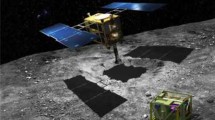Abstract
CIVA (Comet Infrared and Visible Analyser) is an integrated set of imaging instruments, designed to characterize the 360∘ panorama (CIVA-P) as seen from the Rosetta Lander Philae, and to study surface and subsurface samples (CIVA-M). CIVA-P is a panoramic stereo camera, while CIVA-M is an optical microscope coupled to a near infrared microscopic hyperspectral imager. CIVA shares a common Imaging Main Electronics (IME) with ROLIS. CIVA-P will characterize the landing site, with an angular sampling (IFOV) of 1.1 mrad: each pixel will image a 1 mm size feature at the distance of the landing legs, and a few metres at the local horizon. The panorama will be mapped by 6 identical miniaturized micro-cameras covering contiguous FOV, with their optical axis 60∘ apart. Stereoscopic capability will be provided by an additional micro-camera, identical to and co-aligned with one of the panoramic micro-camera, with its optical axis displaced by 10 cm. CIVA-M combines two ultra-compact and miniaturised microscopes, one operating in the visible and one constituting an IR hyperspectral imaging spectrometer: they will characterize, by non-destructive analyses, the texture, the albedo, the molecular and the mineralogical composition of each of the samples provided by the Sample Drill and Distribution (SD2) system. For the optical microscope, the spatial sampling is 7 μm; for the IR, the spectral range (1–4 μm) and the spectral sampling (5 nm) have been chosen to allow identification of most minerals, ices and organics, on each pixel, 40 μm in size. After being studied by CIVA, the sample could be analysed by a subsequent experiment (PTOLEMY and/or COSAC). The process would be repeated for each sample obtained at different depths and/or locations.
Similar content being viewed by others
References
Bibring, J.-P., Soufflot, A., Berthé, M., Langevin, Y., Gondet, B., Drossart, P., et al.: 2004a, ESA SP 1240, 37.
Bibring, J.-P., Langevin, Y., Poulet, F., Gendrin, A., Gondet, B., Berthé, M., et al.: 2004b, Nature 428, 627.
Combes, M., Moroz V. I., Crifo, J. F., Lamarre, J. M., Charra J., Sanko N. F., et al.: 1986, Nature 321, 266.
Hanner, M. S., and Bradley, J. P.: 2004, in M. Festou, H. Keller, and H. Weaver (eds.), Comets II, University of Arizona Press, Tucson, p. 555.
Irvine, W. M., and Lunine, J. I.: 2004, in M. Festou, H. Keller, and H. Weaver (eds.), Comets II, University of Arizona Press, Tucson, p. 25.
Kissel, J., and Krueger, F. J.: 1987, Nature 326, 755.
Langevin, Y., Douté, S., Vincendon, M., Poulet, F., Bibring, J.-P., Gondet, B., et al.: 2006, Nature 442, 790.
Mustard, J. F., Poulet, F., Gendrin, A., Bibring, J.-P., Langevin, Y., Gondet, B., et al.: 2005, Science 307, 1594.
Poulet, F., Bibring, J.-P., Mustard, J. F., Gendrin, A., Mangold, N., Langevin, Y., et al.: 2005, Nature 438, 623.
Weidenschilling, S. J.: 2004, in M. Festou, H. Keller, and H. Weaver (eds.), Comets II, University of Arizona Press, Tucson, p. 97.
Author information
Authors and Affiliations
Corresponding author
Rights and permissions
About this article
Cite this article
Bibring, JP., Lamy, P., Langevin, Y. et al. CIVA. Space Sci Rev 128, 397–412 (2007). https://doi.org/10.1007/s11214-006-9135-5
Received:
Accepted:
Published:
Issue Date:
DOI: https://doi.org/10.1007/s11214-006-9135-5




